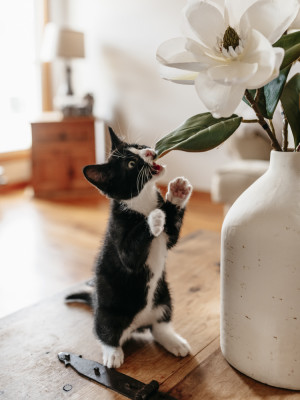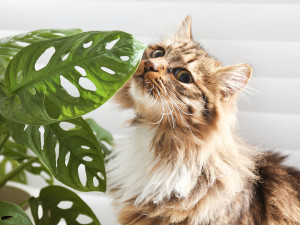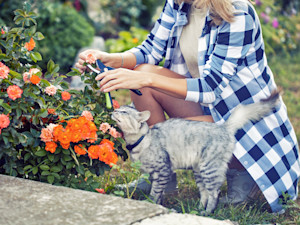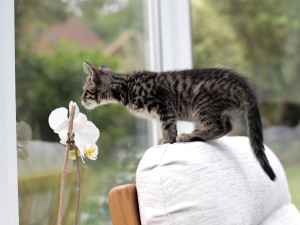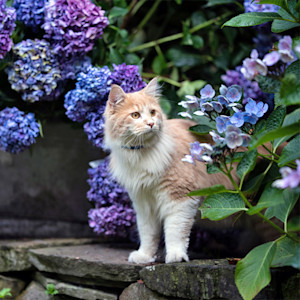Protect Your Cat by Keeping These Toxic Succulents Out of Your Home
Learn about non-toxic options that won’t harm your kitty.

Share Article
There tends to be quite a crossover between cat lovers and houseplant enthusiasts. It must have something to do with having a nurturing nature. However, it can be a little complicated for both loves to live together safely; some kitties want nothing more than to torture indoor plants, and some plants seek revenge through toxicity.
One of the ultimate varieties of houseplants are succulents. Their low maintenance nature makes them great for anyone, no matter the color of their thumb, but some do pose a risk to cats, making them risky options when you want your plants and pets to co-exist.
Are all succulents toxic to cats?
Nature can be a strange and incredible thing. Every being is similar, yet very different from others. So, while succulents are grouped together because of their ability to store water so that they can thrive in dry climates, each one is very unique. All this is to say that some succulents are toxic to cats, and others aren’t. Because it can be difficult to know which ones, we’ll break down the most popular varieties so you know which ones are safe for your kitty.
Succulents that are toxic to cats
You’ve likely run across these plants, or currently have some in your home, so just know that they can cause problems if your cat or dogopens in new tab eats them.

Aloe vera
Spiky leaves aside, aloe vera plants contain compounds called saponins that can cause vomiting, diarrhea, and lethargy. Severe cases can cause muscle tremors and kidney damage. Aloe vera products are every bit as dangerous as the plant, so avoid using them in and on your cat.
Jade plant (Crassula)
Eating a leaf or two from a Jade plant can also cause vomiting and lethargy along with not eating and incoordination. Fortunately, most cases will resolve on their own.
Pencil cactus (Euphorbia)
Also called “Sticks of Fire”, the pencil cactus will make your cat feel like they ate just that as the sap can cause irritation of the mouth and stomach. Drooling, pawing at the mouth, and vomiting may be what you see.
Kalanchoe
Kalanchoe plants contain a compound called bufodienolides that can affect your cat’s heart rate. You may see vomiting, diarrhea, and drooling, and in some cases difficulty breathing, seizures and heart failure.
String of pearls (Senecio)
String of Pearls plants have an irritating sap that can cause skin and eye irritation if your cat rubs on it and stomach irritation if ingested. Drooling, vomiting, diarrhea, and lethargy may ensue. Fortunately, String of Pearls makes a great hanging plant, making it easier to keep out of your cat’s reach.
What should you do if your cat eats a succulent?
Whether you know the safety of the plant or not, if your cat eats any type of succulent, contact your vet for pet poison controlopens in new tab. It’s always better to be safe than sorry. If your cat eats a succulent with known toxicity, be sure to make veterinary contact immediately though most toxicity issues are fairly minor, they can get severe faster than you would like.
Signs of succulent poisoning in cats
Most succulents are considered toxic because they have something in them that’s irritating to the mouth or digestive tract. However, some plants create a little deeper toxicity and can affect other parts of the body as well.
Gastrointestinal issues
First contact with a toxic plant is typically going to be the mouth, so you may see some drooling, pawing at the face, or gagging if your cat ate something toxic. Later you may see vomiting, diarrhea, lethargy or not eating as the plant works its irritation through the digestive tract.
Neurological signs
Some toxic compounds can find their way into your cat’s neurological system where it can create incoordination, tremors or seizures. These toxic signs usually take ingestion of much more plant material than the digestive signs and tend to be less frequently seen.
Other signs
Toxicity doesn’t have to rely on ingestion. Some plants can cause skin irritation if your cat touches them. Look for redness, swelling, or a rash on their face, ears or feet. The rest of the body tends to be fairly protected by their hair. Watery, red eyes may also show up if your cat gets too close.
How to keep your cat from eating succulents
The obvious answer for keeping your cat away from toxic succulents is not to have any in your home, but we all know how difficult that may be to comply with. If you happen to have succulents, or any houseplant for that matter, keep them out of your cat’s reach. Remember that cats are curious and squishy somethings with an earthy smell can be very enticing so they may go to great lengths to get to them.
This means safely hanging them from the ceiling or window sill well above areas your cat can jump or stretch to. High shelves can work as long as there aren’t lower shelves your cat can stairstep up on. You may consider a plant-only room where your kitty isn’t allowed so that they stay safe and the plants can thrive on their own.
Don’t rely on scent or taste deterrents as some cats will plow right through those in order to help themselves to a nibble.
Safe succulents for cats
Don’t worry, not all succulents are off the table if you’re looking for a risk-free cat home. Here are a few that are considered safe. If you have a dog in your home, consider plants that are safe for dogs as well.
Haworthia and zebra haworthia
Echeveria
Hens and chickens (Sempervivum)
Hardy sedum
Burro’s tail
Bottom line
It’s OK to share your home with succulents and cats, but you’ll want to make sure you choose varieties that aren’t toxic.
If you happen to have a toxic succulent and don’t want to re-home it, consider keeping it in a room where your cat isn’t allowed.
Contact your veterinarian if your cat eats a succulent or is showing any signs of toxicity.
FAQs
Why do cats eat plants?
Eating or chewing plantsopens in new tab may become a cat’s pastime for many reasons, including a natural digestive remedy, boredom, stress, a nutrient deficiency, or they just like the taste. No matter the reason, it’s always best to keep your cat from eating plants unless they’re specifically meant for them, such as cat grass.
What happens if a cat eats a succulent?
Not all succulents are toxic, but those that are can cause digestive issues and irritation, such as drooling, vomiting, diarrhea, not eating and lethargy. Some can even cause incoordination, tremors or heart issues.
Can cats live with succulents?
It’s possible for cats to cohabitate with succulents, even ones considered toxic. While it’s definitely safer to not have plants that can negatively affect your cat, keeping them well out of reach or safely locked in another room can work.
How do I stop my cat from eating succulents?
You really don’t want your cat to eat any succulents, even ones that aren’t considered toxic, so keep your plants up high where your cat can’t reach them or have a cat-free room where your plants can reside. If these aren’t possibilities, you may be able to effectively cage the plant off, but this may be a riskier option.
References
ASPCA “Animal Poison Control.” ASPCA, 2015, www.aspca.org/pet-care/animal-poison-control.opens in new tab

Dr. Chyrle Bonk, DVM
Dr. Chyrle Bonk has been a mixed-animal veterinarian since 2010, with a special interest in rehabilitation. When she's not practicing or writing about veterinary medicine, you may find her exploring the outdoors with her family or tending to her cows, horses, chickens, or cats and dogs.
Related articles
![Closeup portrait of calico cat sitting on home kitchen room table by pink rose flowers in vase, windows with blinds.]()
Are Roses Toxic to Cats?
They sure do like sniffing around those bouquets...
![Woman gardening outside with her cat.]()
Non-Toxic Flowers That Are Safe for Cats
And flowers that aren’t safe, too.
Are Carnations Toxic to Cats?
If you receive this flower in a bouquet, keep it away from your cat.
![Half-bengal kitten indoors smelling white orchid flowers in a conservatory.]()
Are Orchids Toxic to Cats?
Find out whether you can get that elaborate flower arrangement—or if you should skip it.
![a cat peaking out from some hydrangeas]()
Are Hydrangeas Toxic to Cats?
They make your lawn look picture-perfect, but keep your cat away. Here’s why.
Are Petunias Toxic to Cats?
If your kitty is poking exploring your garden, this flower isn’t much of a danger. Here’s why.

